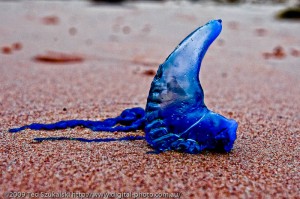You’ve probably seen the cartoons of the person who is urinating on someone who is suffering from a Jellyfish sting.
Jellyfish stings, especially from some – are painful experiences for those who want to enjoy the water in the ocean. As a result there have been many folk remedies such as vinegar, meat tenderizer, to a slurry made with baking soda and water.
But in North America the most effective remedies are hot water and creams that contain the pain-numbing medicine, lidocaine. Worth keeping in your beach bag if you plan on swimming in the ocean.

This common spray can quickly relieve pain from the jellyfish, as well as prevent the toxins from being released.
Jelly fish leave stingers in a person similar to bees. These contain a sac that contains venom – the first treatment is to try to get these venom sacs off the skin as they keep releasing the toxin. Hot water helps to “denature” the venom. As with bees who leave their stinger, the venom sacs should be scrapped off and not pulled off. Pulling them can result in crushing the sac and releasing more venom.

Magnifying tweezers can help you remove painful stings without disrupting the sac. Also useful for taking out splinters. Another tool for your beach bag and vacation
Sometimes the jellyfish will leave behind an entire tentacle – and that also needs to be removed- but not with your hands.
If you plan on swimming in the golf of Mexico or in Florida where there are Portugese man-of-ars, or bluebottles then vinegar helps ease the sting. They seem to be the only species. Again, not commonly found in the beach bag, but we would recommend it.

Often they are not this blue – but have just a blue little sac. If you see these on the beach- don’t pick them up
So- for your beach bag first aid kit we recommend:
Lidocaine containing spray
Vinegar if in Florida or along the Gulf coast
A thermos bottle with some hot water in it
A pocket knife to scrape the stingers off
Better than the knife is to get a magnifying tweezer
Tongs to remove a tentacle

Another way to remove the stinger of the jellyfish- or a bee – without causing the sac to release its toxin
Be lucky we don’t live in Australia where some small jelly fish have venom so powerful it can kill people.






I’m curious if any media outlet was aware the FDA issued two health safety warning related to the application of lidocaine..the adverse effects are significant ..also Lidocaine/prilocaine eutectic mixture is marketed as a 5% oil-in-water emulsion incorporated in a cream base (EMLA cream) or a cellulose disk (EMLA patch). The cream is applied under an occlusive dressing, while the patch incorporates an occlusive dressing to facilitate absorption of lidocaine and prilocaine into the area where anaesthesia is required. Local dermal anaesthesia is achieved after approximately 60 minutes….60 minutes???? It is important to note that E. Fougera & Co., makers of the generic cream widely used in the United States as Lidocaine and Prilocaine Cream, 2.5%/2.5%, recommends different timing for application of the cream as well as length of anesthesia. They state the cream must be applied at least one hour before the start of a routine procedure and for two hours before the start of a painful procedure.
I will say the rest of your protocol is correct and medically supported by the application of a lidocaine product does nothing but cover the pain…it does not neutralize the nematocysts.
Give me 5% acetic acid..it’s safer and been the center of meaningful marine envenomations for decades supported by a long list of medical and scientific research…good luck and keep your sunny side up..
BL
You are mistaking the application of lidocaine topically to prevent a pain from one type of stimuli vs. preventing the sac from discharging and providing immediate relief. The lidocaine works to prevent the cyst from discharging.
This was not a news outlet issue- this was published in a journal for Emergency medicine- and they tested this. It is common for people to make the mistake of thinking by reading a label they know the mechanism of action for things– this is why we test them. In this case, lidocaine has been tested a number of times and proven to be very beneficial for its use in jellyfish stings. Science is a bit of theory, but a lot of experimentation.
Here is a copy from the abstract of the paper that this was tested in:
Jellyfish tentacles in contact with human skin can produce pain swelling and redness. The pain is due to discharge of jellyfish nematocysts and associated toxins and discharge can be caused by a variety of mechanical and chemical stimuli. A series of tests were carried out with chemicals traditionally used to treat jellyfish stings e.g. acetic acid ammonia meat tenderizer baking soda and urea to determine if these chemicals stimulated or inhibited nematocyst discharge and if they brought relief to testers who were exposed to jellyfish tentacles. Chrysaora quinquecirrha (sea nettle) Chiropsalmus quadrumanus (sea wasp) and Physalia physalis (Portuguese man-of-war) were used in the study. It was found that many of the chemicals traditionally used to treat jellyfish stings stimulated nematocyst discharge and did not relieve the pain. However there was immediate relief when a common anesthetic lidocaine was sprayed on the skin of testers in contact with jellyfish tentacles. Initial exposure of tentacle suspensions to lidocaine prevented the nematocyst discharge by subsequent exposure to acetic acid ethanol ammonia or bromelain. Thus lidocaine in addition to acting as an anesthetic on skin in contact with jellyfish tentacles inhibited nematocyst discharge possibly by blocking sodium and/or calcium channels of the nematocytes.
Comparative Biochemistry and Physiology Part C: Toxicology & Pharmacology
Volume 151, Issue 4, May 2010, Pages 426–430
Thank you for your reply and supporting data…Respectfully, I still disagree with the representations in the most recent report from UC San Diego based largely on two factors…The FDA health advisories issued 2007 and 2009 related to the application of topicals…..
http://www.fda.gov/NewsEvents/Newsroom/PressAnnouncements/2009/ucm109068.htm
The second is the potential for the injured, in a heightened panic, to over self medicate and thus run the risk of an adverse effect as a result of absorbing high levels of lidocaine..
Recognizing your point and by the same measure, it is not without theory and experimentation that these negative reactions become a potential problem when there is overwhelming fact based science that recommends 5% acetic acid on jellyfish envenomations…Vinegar versus a potential harmful risk? I just don’t see the merit in that……Thanks again and keep your sunny side up..
BL
The more we know about the animals, the less moiatvted we are simply by fear. With knowledge to back us up we are more likely to act appropriately (rather than just instinctively) when we encounter a venomous animal, resulting on a better outcome for both animal and person.